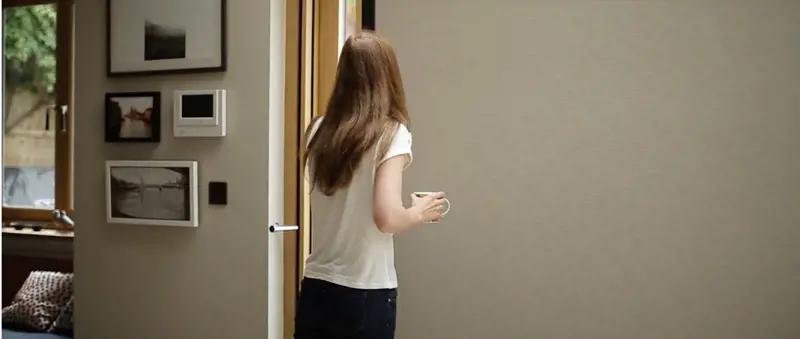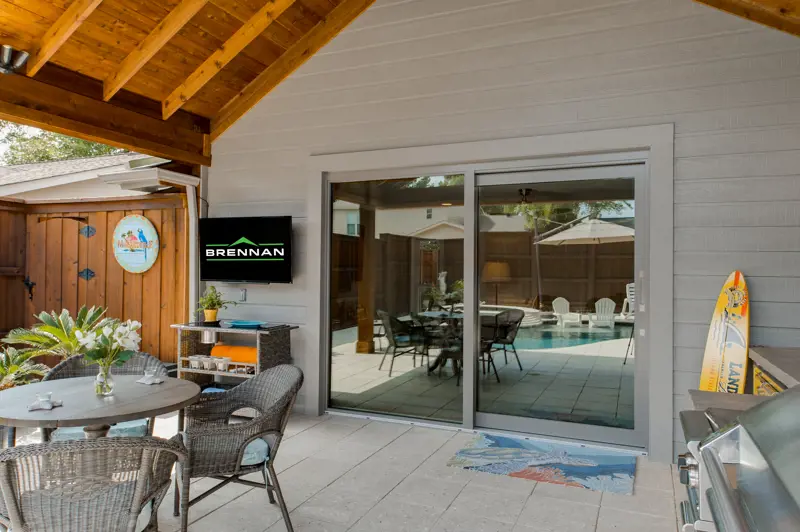Video Transcript
Hey there. Thanks for tuning in. Today, I'm going to showcase some big door projects from dwell.com. Dwell.com is a website and publication that features great, awesome, wild home improvement and commercial projects. So I definitely recommend you check out dwell.com. Today, I've got seven photos of big door projects that I've found on their website that I just want to go through in a little bit more detail, talk about maybe why that door makes sense, maybe why it doesn't, as well as how you might take these photos and use them as inspiration for your next project. So here we go.
This photo is of a black-clad home. It looks like we have some-- either LP SmartSide siding or just traditional wood siding that's been painted a really dark black charcoal. And from what I can tell, the wood species here looks like maybe a Douglas fir vertical grain. They've got a two-panel sliding patio door right up front. This looks like a back patio for them. Nice landscaping, great patio furniture.
A lot of times, a sliding patio door is used because you don't want that in swing or out swing, those door panels kicking into furniture or plants. And so you can see here that one-panel access, it keeps everything tight. So they have some nice planters on the patio, very clean, very simple. I love the way the knots from the cedar deck contrast with that tight vertical grain pattern of the door and the windows. So this project was obviously very well thought out and meticulously designed. Beautiful patio door.
I can't see any other door working for this setting. Especially because the landing is so small outside of the door, if you had two big door panels kicking out, good luck putting anything on the landing. So I think a sliding door is the right choice. It's a beautiful product, a beautiful execution.
OK. This next project is a huge, I mean huge, oversized, two-panel sliding door. It looks like this left panel is going to slide from left to right on the inside. It's a great way to get a ton of sunlight into your kitchen. It's a great way to replace a wall with glass.
Whoever designed this, they knew what they were doing right. So it's beautiful. It's right by the dining room. It's the same scenario as the first one. You can't have a hinged patio door here. That panel is too big. So just think if you had a 5-foot piece of glass swinging all the time. You got kids. You got dogs. Just the weight of that alone would cause concern for me. So I love the sliding implementation. It's a great product. The black contrasts with the white. Very sleek, very contemporary. Lots of visibility. You can see they've got a little water feature here in the back. They've got tile. Gosh. I can't imagine closing that up with wall, so kudos to these folks.
Ah. So a lot of-- pretty much all of your opening doors, your folding doors, patio, gliding, all these big doors are going to be on the back or side of the home. And gosh, these folks here, they have a great setup. It looks like they've got at least a four-panel bi-parting door, because you can see in the middle where that gentleman looks like he's pouring a cup of hot tea, maybe, the panels in the middle are going to slide out. So that configuration is pretty traditional in terms of looking at multi-glides or lifting slides that are available today. That's just a bi-parting door, and it's beautiful.
Gosh. I can't tell the height, but I would say that that's at least probably 10 feet, maybe a little more. There's only a select number of vendors that can make a door this size. So just in terms of your space, think about your maximum width and height and talk to your contractor, your general contractor, your architect, and ask them what vendor makes the most sense for that opening. So it's a little off topic here, but if you're looking at construction costs for a wall versus a door, a lot of times, whenever you're looking at these big doors, they seem expensive. So a really big door, a really big opening can cost tens of thousands of dollars.
But think about what goes into a wall and the number of trades and time it takes to build that wall, whether you're looking at 2-by-6 framing, sheet rock, texture, paint, finish, wiring, exterior wall cladding, weatherization on the outside. There's a lot that goes into a wall that those costs you don't really see or notice. Whenever you're looking at a door itself, it's like, oh, that might be expensive. It's more than I thought it would be. But it's because there's nobody that can really show you the cost of building a wall.
And so if you could say, hey, give me the cost to build the wall and then compare it to a door, that's a worthy question to ask your general contractor or your architect. So these folks, they have a great setup. Probably I'm thinking a 16-by-10 opening is what this looks like to me. That bi-parting is going to give you almost 50% visibility and usable space. And they went with sliding because they've got furniture. They have a nice water feature. It's a great design, great structure, and it's beautiful. Hats off.
Yeah, so when you look at this, you're thinking, that's a nice view. I could live there. I don't know so much about the chain link fence. I think maybe they missed the boat there, or their videographer or photographer didn't edit that the way maybe he could have to make it look a little crisper. Nothing like a million-dollar view with $100 fence, but not my house.
So in this setting, they've got a stacking door. You can see on the left-hand side of the frame, it looks like there's one, two, three, four panels. So I would say that this is probably at least a 16-foot-wide by 8-foot-tall opening. It's probably not any taller than 8 feet based on what I can see. So you're talking about four panels, 16 by 8, and they all stacked to one side. It's a beautiful way to get a clear opening versus a bi-fold door they're going to stack on one side. Or even an in-swing, out-swing door, you're not going to get this clear opening.
One thing to consider when you're doing a clear opening like this is bugs and privacy. So if those things are important to you, you want an insect screen, or you want a shade for privacy. Ask your contractor, your architect builder about integrated screens or shades. What you want is you want to be able to seamlessly bring into the fold an insect screen or a shade so that you can block off that entire wall with some sort of shield. So gosh, in Texas, we have mosquitoes and other bugs. So you don't necessarily want a 12-by-8 opening to just be open. Not to mention, it's hot. So that's another story for another time.
Centor is a product that we carry that has an integrated screen and shade. So on either side of the door, there's a hidden spool, and you can actually bring that screen or shade all the way across the door to provide you privacy or protection for bugs. So if you live on Lake Como or maybe where this house is-- maybe this is somewhere tropical-- maybe bugs aren't a big deal. Maybe they are. So just something to think about is bug and privacy whenever you're talking about these big doors.
Moving forward, what we have here is another big sliding door. Now, the thing we can't see in this picture is, is the entire unit just two sliding doors, or is there a really, really big sliding door paired with a standard hinge door? We don't know. We can't see the full picture. What I do know is all this white design and glass is beautiful.
So big doors accomplish a few things. One-- visibility and light. So depending on your architecture or your designer, you may be playing with light. You may be trying to figure out how to situate your home on your property, on your lot, to give you the best light at a certain part of the day. You also may be looking at what you're doing outside, whether you have a pool, a landscape, or a patio. So these big doors are just going to give you a line of sight outside.
So these doors are not standard. They are very custom. So what we're looking at here are probably-- I'd say 12-by-15 for the opening, maybe a little wider, steel patio doors that have to be heavy, heavy, heavy. This is not a standard application. I saw this photo. I thought to myself, that would be cool to have, but I don't know that I'm strong enough to get the doors open.
So beautiful project, huge steel frame, energy-efficient glass. It's great. Usability-wise, this is not for everybody. You can't put any furniture there. I don't know how they even have plant-- oh, the plants are behind the windows. So that, to me, seems like a bit of a hazard. I wouldn't do this, but I wanted to show it because it's cool.
In this photo, we're looking at a pocket door system. So if you can imagine this opening, it starts with probably three panels, and each of those panels recesses back into the wall. It gives you a clean, crisp, unobstructed view of whatever is outside. So we have this door system from Andersen that can accomplish this, but Andersen is not the only one. I think Pella probably has one. Marvin has one, NanaWall, I think Panda. There's a bunch of vendors that can accomplish this.
But a lot of times, this is hard to do if you're replacing a product because you might not have the wall cavity to accommodate those panels or you might not have the depth of wall. So if you're building new, figure out, do I want doors that completely go away? Do I want folding doors where they all stack to one side, or do I want traditional bi-parting doors where all of my panels are in focus and right up front? So depending on where you are in construction or replacement, a pocket door may or may not make sense.
And that's all that I have for today. Thank you so much for joining. I plan on doing this more and more often where we take project photos that we're big fans of, and we just talk about them. In the notes and comments below, we've linked out to each of these individual projects on Dwell. Again, Dwell is a place and a source of inspiration for us, and we recommend for you. Please go take a look. Enjoy their gallery. And thanks for watching.







